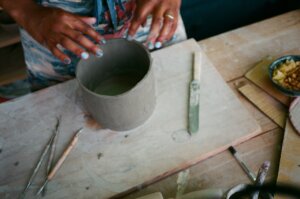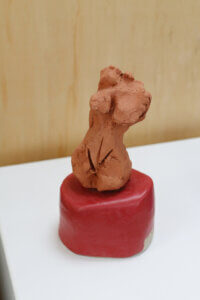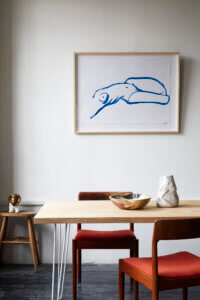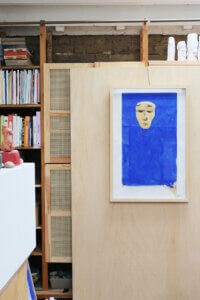Urban Explorer Series: Interview with Ana Kerin
“To me, it is about “keeping your curiosity sacred”. I find cities very inspiring, and being an urban explorer for me is about being open to the unexpected, for surprises and to look under the skin and under the surface of the city. That is where its true heart is and where all the magic lies.”
Ana Kerin
Artist and Founder of Kana London Design Studio
Our Urban Explorer
Could you please introduce yourself to our guests?
My name is Ana and I am an Artist and Founder of Kana London Design Studio. I was born In Yugoslavia but grew up in Slovenia, then moved to London in 2012. I feel that all three of these places strongly define me as a creative and has made me into the person I am now. I was trained in Art from pre-high school, then I attended an art high school and went on to studying Sculpture and Fine Art at the Academy of Fine Art and Design in Ljubljana, Slovenia and NCAD Dublin.
What is your fascination with ceramics?
I first fell in love with clay, then my love for ceramics came second. I feel clay is like “earth” and it has always been and always will be such a fascinating material to me. At the same time, I also feel as if I never really understood it. I manipulate it, but equally it manipulates me.
Clay is an interesting material as it is ancient. We can work with clay on very different scales, from construction and architecture, as well as in agriculture, to art, design and traditional pottery. It also requires one to master the delicate act of working with air, water, earth and fire. In essence, it’s all a balancing act. And it feels so primitive yet so contemporary.
You graduated with a fine arts degree, but how did your studies propel you into the world of ceramics and sculpting?
First and foremost, I am very much still an artist. This is the practice that is the most natural to me.
Kana has always been a design studio in a way. It is constantly evolving when it comes to my work, but it is a place where I am not just an artist. Here, I can work with my knowledge and creativity, and push the boundaries that allow me to step into different areas of work. It allows me to be collaborative, and work on functional pieces which I always found intriguing. The realm of art and design did not use to be as far apart as they seem now days.
Kana has always been about experimenting, a place where I love bringing together elements that might not obviously come together otherwise. I actually started working with chefs before they were deemed as “pop star” celebrities. It was very experimental, and most of the chefs and fine dining at the time still swore by “the white porcelain plate”. But some embarked on a journey of pushing the boundaries with me, and looking back now, it is hard to even imagine that this was a thing.
Now we work also in glass and launching our very first line of furniture pieces.
It all started mostly with design and creative consultancy in design work where the lines between art and design blurred. Now, Kana is a well-established studio, and I am looking forward to expanding my work with more different materials as well as carving out more time for my painting and sculpture.
It’s not always easy to find work that stems from our passions and gives meaning to our lives. Could you always foresee that you would be running your own studio one day?
Definitely not. And it is ever evolving. I still now don’t see it as such. It is an extension of me and my work. And it is the hardest thing to define. And we need to allow the change to be present, to accommodate the idea that our work is always evolving. As an artist, I need to reflect on what works and what doesn’t as my personal needs may change the bigger picture.
What does a day in the life of Ms. Ana Kerin look like?
Never the same; much less glamorous than one might imagine. Clay and studio work requires a lot of heavy duty lifting while trying to juggle hands-on work, with design and creative work taking precedence above all the admin and customer and client relationships. There is a never-ending to-do list, which is a sensitive dance between feeling overwhelmed and finding a balance that works well for me. I think working for yourself is often challenging and so I try to have days dedicated to either being at the office, creating, or doing more hands-on work. It is certainly not easy. But most importantly, learning to work with your energy work flow. I have learned this through practising yoga, listening to my mind and body and being aware of which days I feel sharp and focused, creative or slow, and then make the most out of that energy. You will be your happiest and best self too.
What does “urban explorer” mean to you, and how do you think you fit into this term?
To me, it is about “keeping your curiosity sacred”. I find cities very inspiring, and being an urban explorer for me is about being open to the unexpected, for surprises and to look under the skin and under the surface of the city. That is where its true heart is and where all the magic lies.
Sculpting The Life You Want
Sculpting allows a world of different possibilities, letting you express yourself through various materials, textures, and shapes. What do you enjoy making most?
I do love clay and sculpting. But I love painting more.
In sculpting, I love the transformation of the materials and to see how clay can be transformed when it has been casted in a different material; plaster or bronze, precious metal or when the glass is blown into the mould.
I have a great fondness for unique materials throughout my childhood and materials that I worked a lot with while studying Fine Art – terazzo, stone, wood, brick tiles, glass, raw hemp canvas, as well as welding metal and combining it with marble, stone or clay. But that said, it is painting where my emotions, instincts and ideas flow freely.
What are the basic principles of sculpting? Any tips for beginners?
The most basic principle starts with touch. It is all about connecting with your sense of touch and letting your hands lead the way; connecting them with your instincts and intuition and not allowing your head and eyes (over-thinking and ego) kick in too soon…
I would suggest you get some clay and start following my online tutorial called “clay meditation”, in which it might make you feel totally out of your comfort zone but that is where the good stuff starts.
“We can work with clay as a tool to observe the surfacing of our emotions. It helps us recognise the characteristics of our being and the challenges of our personality. It shows us a reflection of who we are right now. Recognising those feelings and emotions, we learn how to meet ourselves.
It’s a mirror that is so soft that it makes you softer too.
Working with clay teaches you how to change and invites you to apply the changes.
You can slow down, observe, recognise your challenges and start again.
Clay is a forgiving, soft, smooth material that will gently allow you to become
a little more of how you want to be, or a little less of what doesn’t serve you anymore.
I hope it brings you joy.
Love, Ana”
Where does your inspiration come from?
Memories, people, stories. Flavours and excitement. Anything really can inspire me, and plant a seed. Nature as well as emotional states. I love working from my melancholy. It is a very productive fertile place.
Is there a process you go through when it comes to bringing your creations to life?
I work on ideas for a very long time, and some of them might take 15 years before it materialises. I work backwards and forwards between 20 or more projects so this is the way I test my ideas, ensuring I do not “over do them” and making sure they are refined. If they can withstand the challenge of time and my own self-critical analysation, then they are worth sharing with the rest of the world.
You previously mentioned in an interview that you prefer creating ceramics by hand rather than turning them on the wheel because you weren’t fond of the idea of creating perfect pieces. Why is that?
I find perfection very boring and very subjective. It is too symmetric and repetitive.
Repetition of the same form to me is too close to mass manufacturing. When you buy something that has been mass produced, it is always exciting to find that one piece on the shelf that has an obvious “fault” which makes it unique. For example, irregularity in colour or pattern.
There is a beauty in imperfections, they are the true nature.
The traditional Japanese aesthetics of “wabi sabi” (the embrace of transience and imperfection in nature) is very much present in your work – perfectly imperfect. Do you agree?
Absolutely.
How do you think your art and the way you view sculpting has evolved from when you first started till now?
This is a tough one for me to answer. I believe that the core of it has not changed drastically as it is always been about exploring my inner world, so I see it is an ever-evolving journey of self-discovery. Working in art from such a young age and growing up and maturing, I have noticed the change in my relationship with doubt. I went from having no doubts (being young and oblivious) to possessing self-doubt, which I felt at the time was sort of a self-reflection phase. Now, I am in a different phase of having “no doubts” where I know how to be true to myself and not to be apologetic when it comes to that. That is what has changed the most for me.
I also think that my relationship with materials have changed a lot since I started. I am much more conscious of different materials that are not healthy for us to work with or be around. This was not something that was common sense in the 90s. Even growing up in a vegetarian household, we would very much be aware of organic food, which wasn’t common in Yugoslavia. However, materials we used in art school were pretty much anything you could find on construction sites and hardware stores, so it took us a while to find alternatives.
Kana embodies this belief as well; to elevate your every day and rethink your space and the objects you surrounded yourself with. By being a conscious consumer and surrounding yourself with things that create a healthy living environment for you, it will encourage healthy habits. Clay, glass, stone, metal, wood, for instance, allows you to stay true to basic materials. With art, it is harder sometimes to compromise on the materials.
Some people see art as a luxury, but in fact it is deeply weaved into society and into our everyday lives – from fashion and architecture to homeware. Your work is a prime example of this. What are your views on this?
On a relative level, I believe that the gap is closing. The price is not what defines art and its value. The value is subjective to the viewer. If it makes you feel something and it works for you, then it is good art. It doesn’t need to be a piece of art that makes someone else feel something too. Here is where craft and art come together. The line is blurred between functional art and art that is set on a plinth. That is also where with Kana, I position my work and beliefs.
On an absolute level, I am aware that art has always been and always will be a privilege. It doesn’t feed you and it doesn’t put a roof over your head so you feel warm, but it does enrich the soul and expand the mind.
Travel Inspiration
You organise many artistic sculpting retreats and workshops. Do you think your work gives you the freedom of travel?
Pre-Covid – yes, absolutely. It was always my choice of travel, to either learn and explore and connect with other artists, designers, makers, and artisans. And I loved creating opportunity for others to travel with purpose. Now, I hope we will be given that freedom of travel again. It is what expands our minds. And it will be hard to grow on both a personal and collective level if this is taken away from us.
What role does travel play in the art of sculpting?
It is where my curiosity and inspiration come from. It has helped me grow and expand my horizons, the textures and flavours that have fed my inner world for a long time.
Where does your inspiration for travel come from?
Very often it comes from books I have read and vice versa! I would always buy novels that have been written in places I will be visiting, or the writer is from that country or place.
What destinations are on your bucket list?
To be honest, I would love to revisit some of the places I have already been to, like Mexico and West Africa. They are my first choices to travel to when we can travel again.
On my bucket list of places, I have not yet been, it would be Iceland, Hawaii (because of the incredible volcanoes), some of the islands in Japan, and Madagascar.
What was your first impressions of London when you first arrived? What about now?
Grey, cold, damp, distant, walls. Not connected nor welcoming. And I was wondering how many cups of tea one could drink in a day. I did not understand the concept of a pub or that night life is over when pubs close; that is when we will only head out for the club.
It was absolutely not love at first sight, and I found London to be very tough. I came here as an au pair while I was finishing up my dissertation for my critical view on contemporary art, as well as my BA/MA studies. I was 24 when I moved to London. I left behind an identity and only had what felt like two carriers with me at the time. I also arrived with a broken heart.
Slowly, I started seeing beyond the surface. First, it was the vast sky; the low clouds moving so fast in a windy atmosphere of what still is an island. When the evening set in and the streets would get dark at around 7pm in the evening, the sky would illuminate in the most magnificent back-lit blue colour and with it, the streets would fall into the night. The glorious sunset was absolutely mesmerising – Turner was painting just what he saw!
And dunking biscuits into cups of tea. Then marmite. The long summer nights. And I love the sense of melancholy in the city when it rains because they tend to be very productive for me.
I love Londoners. Everyone I have ever come across has been so generous with their advice and sharing knowledge. There is true collaboration. It almost feels as if we found a piece of home and family within each other as everyone is so far from their motherland. I also love the English politeness, like the queuing, for example.
I am sorry I got carried away. How I see London now? Much more conservative than I want to believe it is. It is still most precious and close to my heart.
Has there been any challenges and learnings of living in this city?
Yes – being far from home and from nature. And finding the balance when it comes to over self-indulging in everything that is available. You cannot live on just going to exhibitions and shows very night. I would binge eat through social gatherings and events, and then be hungry for more. I had to learnt to allow myself time to process and reflect on my experiences in between. London is a very stimulating yet socially exhausting city. I can also be lonely and full of solitude so you need to have tough skin to learn how to play it.
How has this city inspired your work? Why?
Maybe it is the separation from the familiar and from where I grew up. Sometimes, I think that the heightened difference, or perhaps what I felt lacking in my current environment compared to my post-Yugoslavian and Mediterranean upbringing makes me see things much clearer. The contrasts between my home and London are what makes London so appealing and inspiring to me. It is actually what creates memories – actual memories! And the freedom of being unknown, always a stranger and anonymous, allows me to observe and people watch while soaking in the life of the city. I really do find people and their stories very intriguing and the way they do things different from me. It makes me think. It has been and still is inspiring for my work – the textures, the people and their experiences are what makes it so rich. And what makes it so hard now during lock down is that it has been made into a very one-dimensional experience.
When you are not working or hosting workshops, which areas of London do you enjoy hanging out at most?
East and South East.
What must-have items do you carry with you when you go exploring in London?
A jumper! Even on a hot summer day – believe me, you will need it in the evening.
I think I gave up on handbags – I wear backpacks and always carry with me an additional tote bag as you never know what you might come across. I’ll also bring with me red lipstick in case lunch becomes dinner or a night out.
Being a London local, how would you describe the city in 3 words?
Stimulating, Unexpected, Melancholic
Are there any London best-kept secrets that you can share with our audience?
It would not be a secret anymore if I shared it! Some places have to be found.
What makes this part of the world so special?
The English weather. It never stays the same for longer than an hour.
When you need an escape outside the bustling city, which places would you recommend to make a nice getaway by car?
- The ponds in Hampstead Heath for a swim (No car needed)
- Chiswick Car Boot (Every first Sunday of the month)
- Margate and a nice lunch in Marina or dinner at Angela’s Sustainable seafood restaurant
- Tillingham vineyards



